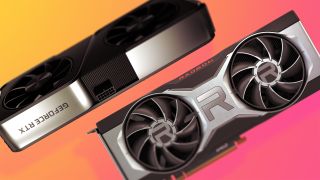Nvidia's tiny, bus powered RTX A2000 pro graphics card delivers RTX 3050 level gaming performance
Someone, please give us a low powered GPU option!
It’s a bit of a shame that current generation Nvidia and AMD cards put a low priority on power efficiency and performance per watt. Big benchmark numbers sell cards more so than relative power consumption numbers. But, there are many users who don't run beefy power supplies or use OEM systems that can’t accommodate enormous graphics cards. There’s a market for low power cards.
Sadly though, there aren’t any current generation GeForce or Radeon cards that have a low enough TDP to omit PCIe power connectors. Even the weak RX 6500 XT can't manage it, but there is an Ampere card that can. It’s the workstation oriented RTX A2000. It features a 70W TDP which is low enough to draw power exclusively from the PCIe slot. Can it game though? That very question was asked and answered by youtuber RandomGamingHD, who ran the little A2000 though a suite of benchmarks.
The A2000, despite its intended workstation optimization, is perfectly capable of gaming and it supports ray tracing and DLSS. It's a low profile dual slot card that features a blower style cooler and it won’t have any issue integrating into virtually any system.
The RTX A2000 is built with the GA106 GPU, the same as that which powers the desktop RTX 3050 and RTX 3060. Its shader count is 3328, which is much higher than the 2560 of the RTX 3050. To achieve its low power rating, the A200 is clocked much lower, with a 562/1200MHz base/boost clock compared to the 1552/1777MHz clocks of the 3050. However, the desktop 3050 has a base 130W TDP, a full 60W more than the A200.
The results show that the A2000 competes surprisingly well with the desktop RTX 3050 despite its significant clock disadvantage. RandomGamingHD shows the A2000 is able to comfortably play games at 1080p and even 1440p if you dial back the settings. Sure, its not an RTX 3090 or RX 6900 XT slayer, but at 70W, it offers excellent power efficiency, and that's the major takeaway from this experiment.

How to buy a graphics card: tips on buying a graphics card in the barren silicon landscape that is 2021
Sadly, as the A2000 is a workstation card, it's very expensive. At $1,070 it's far too expensive to compete with the RTX 3050 and RTX 3060, but it serves as a good example of what’s possible when power efficiency is the design goal, and not brute force.
I use a 75W passive GTX 1050 in a secondary PC, and I love it specifically because it’s a silent and low power option. I’m sure I'm not the only one who values these characteristics. A current generation sub 75W GeForce or Radeon card would earn a lot of fans. I’m ready with my wallet open.
The biggest gaming news, reviews and hardware deals
Keep up to date with the most important stories and the best deals, as picked by the PC Gamer team.

Chris' gaming experiences go back to the mid-nineties when he conned his parents into buying an 'educational PC' that was conveniently overpowered to play Doom and Tie Fighter. He developed a love of extreme overclocking that destroyed his savings despite the cheaper hardware on offer via his job at a PC store. To afford more LN2 he began moonlighting as a reviewer for VR-Zone before jumping the fence to work for MSI Australia. Since then, he's gone back to journalism, enthusiastically reviewing the latest and greatest components for PC & Tech Authority, PC Powerplay and currently Australian Personal Computer magazine and PC Gamer. Chris still puts far too many hours into Borderlands 3, always striving to become a more efficient killer.
Most Popular






